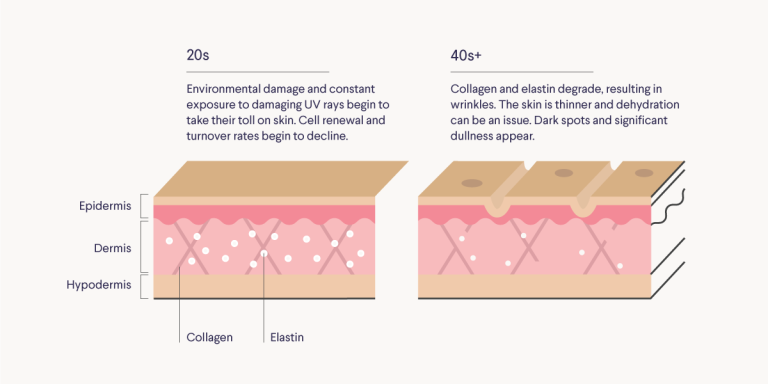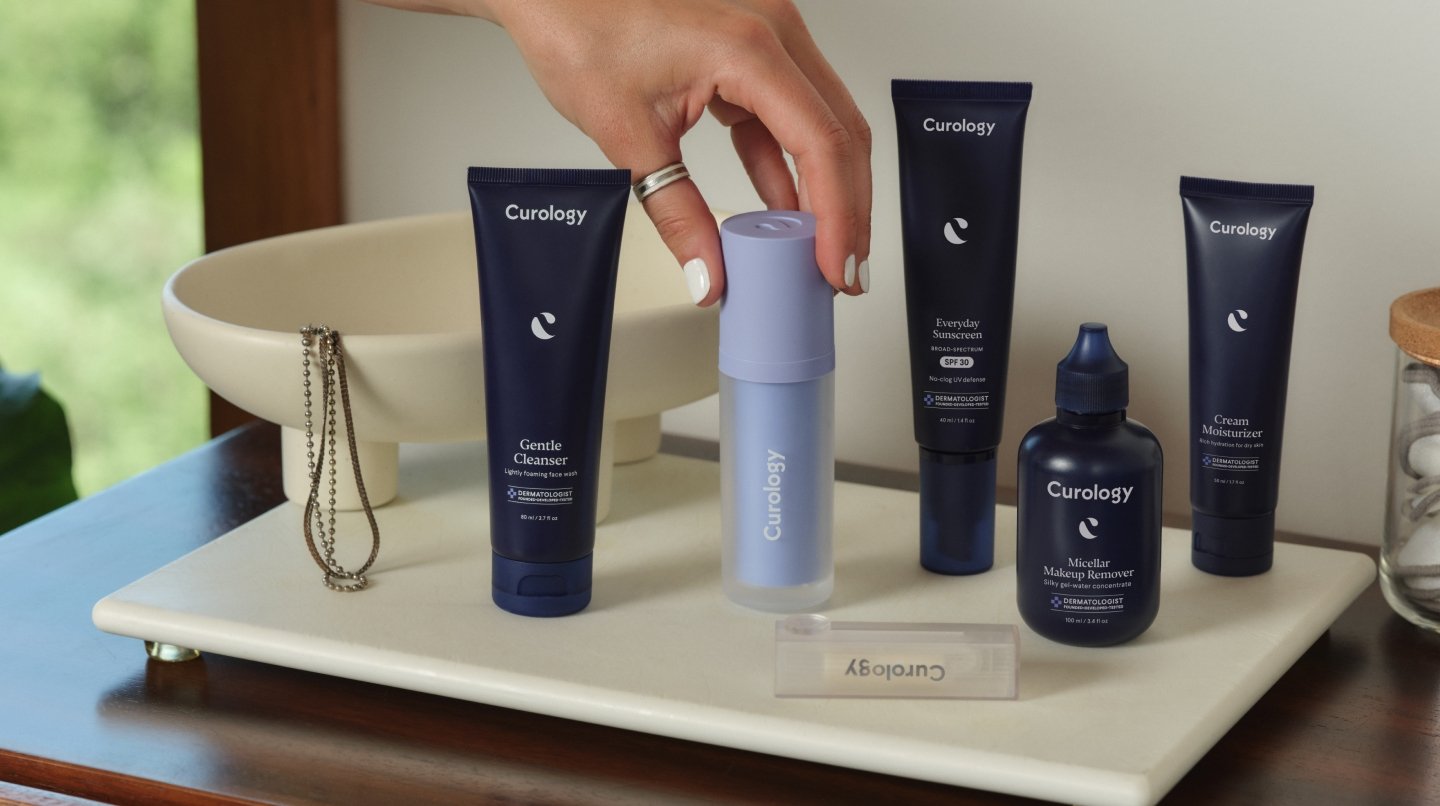How it works:
Share your skin goals and snap selfies
Your dermatology provider prescribes your formula
Apply nightly for happy, healthy skin
How it works:
How it works:
Share your skin goals and snap selfies
Your dermatology provider prescribes your formula
Apply nightly for happy, healthy skin
How it works:
What you need to know about aging skin, from fine lines to wrinkles
Dive into the science of aging skin to learn how you can slow down the development of fine lines and wrinkles.



Noticing your first forehead wrinkle or faint fine lines developing around your eyes may not be a milestone you want to celebrate. But hang in there—everyone gets them—we’re right here with you! So let’s set the record straight: What’s the difference between fine lines and wrinkles, and are they connected? The short answer to the question—the two are similar but different. Wrinkles can start as fine lines but not all fine lines are wrinkles.
Fine lines can be a precursor to wrinkles, but not always. More importantly, fine lines are often a little easier to improve with topical skincare and in-office treatments by a dermatology provider. Wrinkles, the deeper variety, are not easy to “iron out,” no matter how much product you throw at them. We like to think of a wrinkle as a sign of a life well-lived, so we’re not saying you should want to get rid of wrinkles, by the way—to each their own.

All about aging skin
To get the official introductions and definitions out of the way: aging-related changes in the skin are generally linked to a reduction in collagen, elastin, and hydration, all of which contribute to the appearance of fine lines and wrinkles.¹ Skin aging is divided into two categories: intrinsic and extrinsic. Intrinsic aging is the natural aging process involving the passage of years and genetic factors that are not under your control. Extrinsic aging is caused by factors you actually can control, like diet, smoking, sun exposure, and stress management.²
What are extrinsic causes of aging skin?

A quick refresher: The primary extrinsic cause of skin aging is UV rays.³
UV rays can impact your skin by:
Breaking down proteins that give structure to your skin
Stimulating the production of too much pigment, which can lead to discoloration or dark spots
UV rays can also lead to the production of free radicals, which are unstable compounds. When your skin absorbs too many of them, they can end up warping the foundation and structure of your skin—and that's how fine lines and wrinkles can start.
Fine lines vs. wrinkles
Remember: Wrinkles can start as fine lines, but not all fine lines are wrinkles. According to the American Academy of Dermatology, fine lines can result from repeatedly contracting the same muscles in your face over time.⁴ After many years, these fine lines can develop into deeper wrinkles. These shallower fine lines can form when you make facial movements such as smiling, laughing, or frowning. They’re superficial, meaning they’re close to the skin’s surface. As time goes on, however, deeper wrinkles can form that are more challenging to conceal or correct.
Fine lines maybe improved with some topical skincare ingredients, but wrinkles are deeper, and topical treatments won’t resolve them. To soften wrinkles, you’ll need to discuss your options with an in-person dermatology provider.

What are wrinkles caused by?
What causes wrinkles runs deeper than just fine lines gone rogue. Wrinkles can start as fine lines, but not all fine lines are wrinkles! Get it?
Here’s a helpful analogy: Fine lines are like the tip of the iceberg, while deeper wrinkles represent the part of the iceberg underwater that we can’t see. Wrinkles form in the deeper, underlying support structures of the skin.
Remember, changes associated with aging are characterized by a reduction of collagen and elastin and a loss in hydration—all of which happen at a deeper level in the skin and contribute to the appearance of fine lines and wrinkles. Collagen forms the skin’s support structure, and elastin contributes to skin elasticity, or the skin’s ability to bounce back.⁵ You can do your part by sticking to a daily skincare routine, drinking plenty of water, and protecting your skin from sun damage. You can also seek out professional help—more on that later!
Where are common places for wrinkles to develop?
When we smile, laugh, squint, or frown, we contract the muscles in our face. Over time, fine lines—and ultimately wrinkles—develop. Pursing lips when drinking from a straw or smoking (which we hope you’re not!) can also lead to wrinkles. Not only can smoking lead to wrinkles from pursed lips, but cigarette smoke is also a major extrinsic contributor to skin aging, along with other major health risks. Extrinsic factors are superimposed on natural chronological aging. Think of it as accelerated aging. So, if you haven’t already, it’s time to quit smoking.
Some of the most common places people develop wrinkles are around the forehead, mouth and eyes, including between the eyes (the “11” lines). This area is often used for expression, making it particularly vulnerable to wrinkles.
Another common culprit in wrinkle formation is sun exposure, especially on the face, neck, and hands, because UV rays cause damage to the layers of the skin. In fact, sun exposure is a major contributor to premature aging, including wrinkles. UV exposure generates free radicals, damaging skin cells and contributing to wrinkle formation.⁶ So, wear sun protection—always!

What causes fine lines?
There’s no specific age at which fine lines develop. But they’re more likely to happen if you’re repeatedly exposed to the extrinsic factors of skin aging we talked about above. Unprotected exposure to UV rays, smoking, and squinting (for a few common examples) make lines and wrinkles more likely to develop earlier in life.
If you’re starting to see fine lines where you’d rather not, it’s time to start taking your skincare routine—especially sunscreen��—more seriously. Wrinkles are deeper than fine lines, so if you want to help slow the progression of wrinkles, wear sunscreen every day, keep your skin moisturized, and consider “anti-aging” treatments. Curology members can message their dermatology provider at any time to discuss adjusting their treatment plan.

How to help prevent fine lines and wrinkles
We would love to tell you we have the magic cure to preventing fine lines and wrinkles. Unfortunately, we don’t. No one does (and if anyone says they do, they’re stretching the truth). While we can’t prevent everything, we can help slow down the progression of certain signs of aging. Here are some tips to help minimize facial creases, fine lines, and wrinkles.
Wear sunscreen. We know we sound like a broken record, but we can’t stress this enough: Your first line of defense against fine lines and wrinkles is sunscreen!⁷ In the long run, preventing these things is way easier than fixing them later. We recommend using a broad spectrum sunscreen with at least SPF 30, reapplying at least every two hours, and staying out of direct sunlight as much as possible (cover-up, wear a hat and sunglasses…you get the picture). If you’re an existing Curology member, you’ll be happy to know the sunscreen by Curology is a broad spectrum SPF 30 formula that is non-comedogenic, grease-free, blends well, and absorbs quickly to leave no white-cast.
Use moisturizer. Moisturizing is an essential wrinkle-prevention step, too. Not only does it keep your skin hydrated and glowy, but it also helps maintain the skin’s natural protective barrier, keeping everything working smoothly. At night, use a cleanser before applying moisturizer.
Incorporate retinoids. Take it to the next level by using retinoids, such as tretinoin (available by prescription only). Studies show that tretinoin is tried-and-true for helping out our skin in a variety of ways, including boosting skin cell turnover (which makes it helpful for acne, too).⁸ Many dermatologists consider it the "gold standard" of topical treatments when it comes to anti-aging. If you’re interested in using tretinoin, you can ask your Curology provider if it’s right for you.
Eat right. A well-balanced diet with lots of fresh fruit and vegetables may help slow skin aging, and the same goes for cutting back on the sugar. High sugar intake can increase glycation end products, or AGEs, which can lead to functional and structural damage to the skin.⁹ Put simply, AGEs can accelerate the aging process.
Try mocktails. Happy hour with your friends can be a great way to end a busy week, but that doesn’t mean you have to booze it up! According to the American Academy of Dermatology, alcohol can dehydrate and damage the skin. Heavy consumption can also make your skin appear older.¹⁰
Over-the-counter (OTC) ingredients that can help improve fine lines and wrinkles
Retinol is a vitamin A derivative available over-the-counter. Retinol is proven successful in improving wrinkles from aging and sun-damage.¹¹
Alpha hydroxy acid is a chemical exfoliator. It buffs away dead skin cells from the skin’s surface to leave a fresh, glowing appearance.
Hyaluronic acid is your hydration superhero. HA is a humectant, meaning it helps your skin absorb moisture.
Niacinamide is a form of vitamin B3. It protects the skin by neutralizing free radicals. It’s also a powerful anti-inflammatory ingredient.
Antioxidant activity in vitamins A, C, and E can improve your skin. Vitamin C is a strong antioxidant that helps protect against free radicals that can contribute to wrinkles.
How to lessen the appearance of wrinkles
If you’re wondering what can be done about those deeper wrinkles, some options exist to improve them, but most involve a visit to a cosmetic dermatologist’s office. As far as we’re concerned, we aren’t against signs of aging—we’re all about aging well. That means putting health and wellness first, embracing the natural changes we all go through over the course of our lives, and doing what we can to mitigate the extrinsic signs of aging.
All that to say, no judgment if you want to spring for some in-office cosmetic dermatology treatments, such as:
Laser resurfacing
Fillers/injectables
Chemical peels
Microdermabrasion
PRP (platelet-rich plasma) microneedling or injections
Botox
Botox is one of the most common ways to improve hard-to-treat wrinkles. Botox works by weakening certain muscles and blocking the nerves, thus reducing the appearance of wrinkles. Botox lessens the appearance of dynamic wrinkles more than static wrinkles visible at rest.¹² Most treatments last three to six months.
While pricey, these in-office dermatological treatments can offer (in some cases) immediate and lasting results. Topical treatments may help, too—it’s typically a good idea to combine long-term use of topical skincare (like your Curology Custom Formula) with an in-office treatment plan designed to get the results you’re going for. You can always book a consultation in person with a dermatology provider near you to find out what in-office wrinkle treatments may be right for you.

FAQs
Changes associated with aging are characterized by a reduction of collagen and elastin and a loss in hydration, all of which happen at a deeper level in the skin and contribute to the appearance of fine lines and wrinkles.
Some of the most common places people develop wrinkles are around the forehead, mouth and eyes, including between the eyes (the “11” lines). This area is often used for expression, making it particularly vulnerable to wrinkles.
Unprotected exposure to UV rays, smoking and squinting (for a few common examples) make lines and wrinkles more likely to develop earlier in life. They’re more likely to happen if you’re repeatedly exposed to the extrinsic factors of skin aging.
Here are some tips to help minimize facial creases, fine lines, and wrinkles.
Wear sunscreen.
Use moisturizer.
Incorporate retinoids.
Eat right.
Try mocktails, alcohol can dehydrate and damage the skin.
Some options exist to improve them, but most involve a visit to a cosmetic dermatologist’s office.
Botox
Laser resurfacing
Fillers/injectables
Chemical peels
Microdermabrasion
PRP (platelet-rich plasma) microneedling
Start by simply smoothing fine lines with Curology
If you’re looking for accessible, effective skincare, we’re here for you. Sign up for a free 30-day trial of Curology to get started (you just pay $4.95 shipping & handling).* It’s easy: Just take a quick questionnaire and upload photos of your skin, and your Curology provider will make sure you’re a good fit (each provider is a licensed medical professional, so think of it as the online version of an in-office consultation).
Get your personalized skincare routine with Curology
Get your personalized skincare routine with Curology


Your custom Curology medication will be formulated to target your skin-aging concerns with active ingredients that studies show can improve collagen production, boost skin cell turnover, fade age spots, and—yes!—smooth out fine lines. Best of all, we deliver your bottle right to your door and cut out the overpriced mark-ups commonly seen with other “anti-aging” skincare products out there. We’ve got your back!
P.S. We did the homework so you don’t have to:
Zhang, S., & Duan, E. Fighting against Skin Aging: The Way from Bench to Bedside. Cell Transplantation. (2018).
Farage, M. A., et al. Intrinsic and Extrinsic Factors in Skin Ageing: A Review.International Journal of Cosmetic Science. (2008).
Poljšak, B., et al., Free Radicals and Extrinsic Skin Aging. Dermatology Research and Practice. (2012, February 29).
American Academy of Dermatology. 11 Ways to Reduce Premature Skin Aging. (n.d.).
Mehta-Ambalal S. R. Neocollagenesis and Neoelastinogenesis: From the Laboratory to the Clinic. Journal of Cutaneous and Aesthetic Surgery. (July-September 2016).
Gu, Y., et al., Biomarkers, Oxidative Stress and Autophagy in Skin Aging. Ageing Research Reviews. (May 2020).
American Academy of Dermatology. 11 Ways to Reduce Premature Skin Aging. (n.d.).
Mukherjee, S., et al. Retinoids in the Treatment of Skin Aging: An Overview of Clinical Efficacy and Safety. Clinical Interventions in Aging. (December 2006).
Danby, F.W., Nutrition and Aging Skin: Sugar and Glycation. (2010, July-August).
American Academy of Dermatology. 11 Ways to Reduce Premature Skin Aging. (n.d.).
Mukherjee, S., et al. Retinoids in the Treatment of Skin Aging: An Overview of Clinical Efficacy and Safety. Clinical Interventions in Aging. Ibid.
Small, R., Botulinum Toxin Injection for Facial Wrinkles. American Family Physician. (2014, August).
*Subject to consultation. Subscription is required. Results may vary.

Curology Team

Nicole Hangsterfer, PA-C
Related Articles
Ask the experts: How much moisturizer should I use?Is your makeup pilling? Here’s how to help prevent it from happeningSkincare tips for dry skin, according to dermatology providers5 ways to calm sensitive skin, according to dermatology expertsThe best moisturizers for dry skin, according to dermatology expertsPopular Articles
Ask Curology: Is my cold breaking me out?Slugging: The dermatologist-approved skincare hack going viral on TikTokTretinoin vs retinol: What’s the difference?How to create a self-care routine that actually sticksYour 2023 skincare horoscopeTry prescription skincare
Get routine essentials

Good skin days ahead
- Breakouts
- Redness
- Fine lines
- Dark spots
- Hair thinning